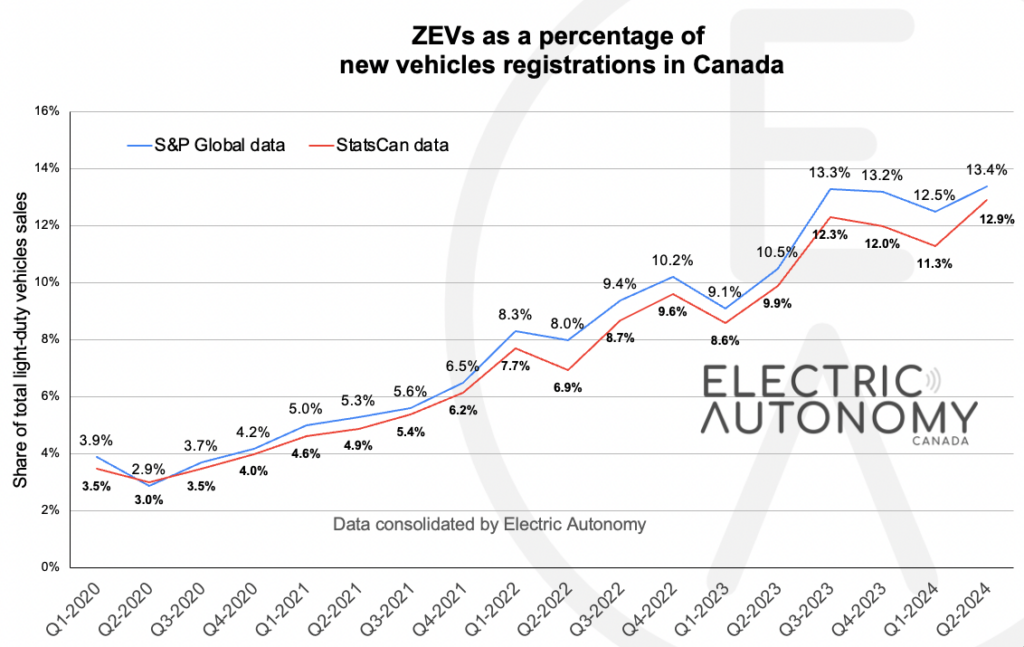Data provider predicts Canada’s zero-emission vehicle market share will hit 16 per cent by the end of 2024, despite widespread talk of a slump in ZEV sales

Data provider predicts Canada’s zero-emission vehicle market share will hit 16 per cent by the end of 2024, despite widespread talk of a slump in ZEV sales
After a slow start to the year, zero-emission vehicle sales in Canada are picking up momentum and Q2 2024 saw them reach an all-time high in market share: 13.4 per cent, according to new S&P Global Mobility data.
This is a nearly full percentage point increase from 12.5 per cent in Q1.
The strong numbers from S&P follow the trend set by Statistics Canada, which last week released its own tally for Q2 2024, showing ZEV registrations in Canada hit 12.9 per cent.

In terms of market share, Canada is outpacing the U.S., which has an overall ZEV penetration of 10 per cent, according to S&P. The automotive intelligence provider also predicts Canada’s ZEV adoption rate will reach 16 per cent by the end of the year.
(Note: S&P Global Mobility, like Statistics Canada, classifies BEVs and PHEVs as “zero-emission vehicles.” The grouping does not reflect Electric Autonomy‘s view, which considers only non-combustion engine vehicles to be zero-emission. However, where statistics in this report refer to ZEVs, we have adhered to the S&P Global definition for consistency.)
Looking only at battery-electric vehicles (BEVs), Canada’s adoption rate hit 9.9 per cent in Q2 2024 versus 9.2 per cent in Q1.
For plug-in hybrid electric vehicles (PHEVs), the Q2 2024 adoption rate is 3.5 per cent, up slightly from 3.3 per cent in Q1 2024.
Provincial breakdown
At a regional level, the S&P data shows Quebec is the leading jurisdiction for overall ZEV volume, accounting for 50.8 per cent of new ZEV registrations in Q2. In terms of the total fleet, 42.7 per cent of all ZEVs on the road in Canada are registered in Quebec.
British Columbia saw a tiny 0.1 per cent decline in new registrations — dropping to 21.8 per cent in Q2 from 21.9 per cent in Q1. It hosts 24.3 per cent of the national light-duty ZEV fleet.
Every other province saw registrations increase or hold steady quarter-over-quarter between Q1 and Q2. Yukon and Prince Edward Island knocked Ontario out of the top four with the territory and Canada’s smallest province placing third and fourth in the ranking, respectively.
Within Ontario, Toronto saw its ZEV volume increased by 36.2 per cent. With respect to the national fleet, Ontario edged B.C. out for second place with 25.9 per cent of ZEVs in Canada registered in the province.
Medium- and heavy-duty adoption
While the numbers are looking up in the light-duty ZEV segment, registration of zero-emission medium- and heavy-duty vehicles (MHDVs) saw a downturn in Q2 compared to Q1.
With the exception of Class 5 trucks, all other zero-emission truck segments saw no growth or experienced a downturn from Q1 2024.
Class 6 and 7 trucks were particularly affected, going from 2.9 per cent and 3.9 per cent in Q1 2024 to 0.9 per cent, each, in Q2 2024.
Overall, MHDVs dropped from 1.2 per cent to 0.9 per cent quarter-over-quarter.






